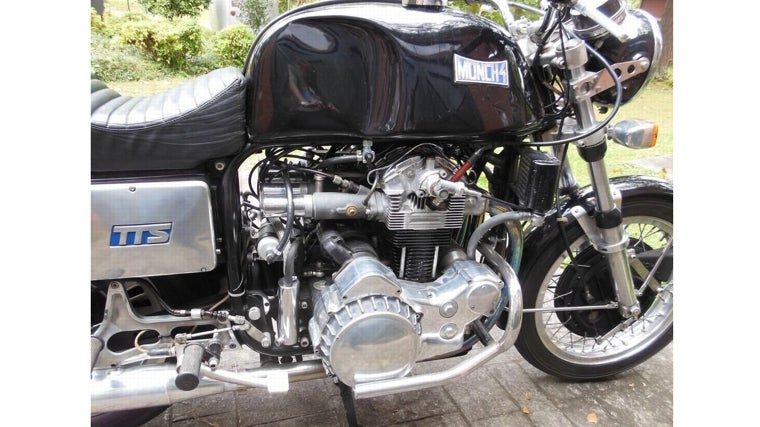The fantastic story of the gigantic Münch Mammut

Freidl Münch, who had founded a small factory in Altenstadt, then West Germany, created the Mammut around a car engine. Not content with the two-cylinder engines that powered most motorcycles of the time, Münch turned to the automotive world, to the engine of an NSU Prinz 1000: a four-cylinder inline, four-stroke, 996 cc, air-cooled, with a single overhead camshaft and a robust five-bearing crankshaft.
It wasn't a simple operation. Münch would have to manufacture an oil pan, a primary cover, and a four-speed gearbox from the defunct Horex. He wanted more horsepower than the standard version, so he had to develop new camshafts or install double-lead Weber carburetors: no problem for Friedl, a hardened engineer and handyman.
And he created a double-cradle chassis made of steel tubes, handcrafted and inspired by the famous Featherbed from the British company Norton, the best of its time. The front wheel was the classic spoked wheel with a huge 10-inch ventilated drum, designed by Münch himself.
For the latter, since a conventional spoked wheel simply wasn't enough to withstand the transfer of the NSU engine's power to the asphalt, he designed an alloy rim (the first for a production motorcycle) with an integrated brake drum. For both the front drum and the rear rim, he used Electron, a magnesium alloy lighter than aluminum, although more difficult to work with and very expensive. He also used Electron for the one-piece seat base and rear fender.
Other innovative features for the time included a 12-volt electrical system with two batteries, a fully enclosed chain case that formed half the swingarm, and even turn signals at the ends of the handlebars.
 Each of the Münch pieces was a unique piece handcrafted
GS
Each of the Münch pieces was a unique piece handcrafted
GS
The Mammut weighed just 227 kg and reached a top speed of around 185 km/h (115 mph). The materials used, the craftsmanship, and the meticulous engineering also made it an incredibly expensive motorcycle—more than twice the price of the BMW R69S and almost three times the price of a Triumph Bonneville. However, this didn't stop Münch from quickly acquiring a substantial order book.
In 1967, Münch made two important decisions. He opened a new factory in Ossenheim, Germany, with 20 employees, and signed an agreement with Floyd Clymer that granted the former racer and famous promoter and publisher (one of the world's most important motorcycle and automobile publishers) the company's distribution rights in the United States, while also appointing him as director of operations for Münch Motorcycles.
A wise decision, as the brilliant Clymer was an excellent businessman, while Münch, a visionary and phenomenal engineer and tuner, was not very financially savvy. Clymer's advertising slogan for the bikes was: "Built up to a Standard, Not Down to a Price." After Clymer's death in 1970, the import of subsequent Mammuts passed through various hands.
As production continued into the 1970s, each machine was a special order; no two were alike. During this time, Münch launched the 115 hp Sport-Münch and later the Daytona Bomb, designed to break the world one-hour speed record at Daytona. At the time, Mike Hailwood held the record, which he set on an MV Agusta in 1965. The Daytona Bomb was faster than Hailwood's MV, reaching average speeds of 286 km/h (176 mph), but the team couldn't find a rear tire that would last more than four laps...
 It would later adopt the NSU 1200 engine.
GS
It would later adopt the NSU 1200 engine.
GS
The Mammut continued to use the original 996 cc Prinz engine until Münch adopted the NSU Type 110 engine. This air-cooled 1200 cc engine generated 85 hp and, with proper tuning, was capable of gaining a few more. This increased performance allowed the car to reach 160 km/h in 11 seconds, vibration-free, and with exceptional reliability.
It had only one real drawback: due to the increased power and torque, the bike ate the rear tyres considerably, and even the most conservative rider was lucky to cover 1600 km on a tyre. In 1973, the Münch 1200 TTS-E became the world's first production motorcycle with fuel injection (a mechanical Kugelfischer) making the bike an Einspritzer, hence the E in its model designation.
But the Münchs were now facing a rapidly changing landscape: Japanese motorcycle brands were arriving, with excellent, powerful, reliable models... and at unbeatable prices.
By the end of 1973, Münch Motorcycles was experiencing financial difficulties, and its founder had to resign. Münch motorcycles continued to be produced until 1980, when the factory finally closed its doors.
In 1991, Freidl Münch returned to build the Münch 2000. It was another extraordinary bike that, as noblesse oblige, also used a car engine: a liquid-cooled 1998 cc Cosworth four-stroke engine with a Schwitzer turbo, producing 260 hp. It used Öhlins suspension and a carbon-fiber fairing, boasting an advanced design. Only 15 units were made (the factory was now in Poland).
Today, it is estimated that just under 500 Munch motorcycles were manufactured, and that only just over 300 survive, indicating that this is undoubtedly a cult bike.
Freidl Münch left this world on April 26, 2014, and behind him an unforgettable motorcycle: "the fastest, most powerful and most expensive of its time," as motorcycle historian Hugo Wilson would define it.
ABC.es





